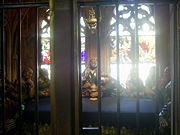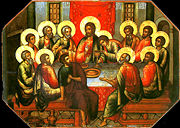Last Supper
2008/9 Schools Wikipedia Selection. Related subjects: Religious texts
According to the Gospels, the Last Supper (also called Lord's Supper) was the last meal Jesus shared with his Twelve Apostles before his death. The Last Supper has been the subject of many paintings, perhaps the most famous by Leonardo da Vinci. In the course of the Last Supper, and with specific reference to taking the bread and the wine, Jesus told his disciples, "Do this in remembrance of Me", ( 1 Corinthians 11:23-25). (The vessel which was used to serve the wine, the Holy Chalice, is considered by some to be the " Holy Grail"). Many Christians describe this as the institution of the Eucharist.
According to tradition, the Last Supper took place in what is called today The Room of the Last Supper on Mount Zion, just outside of the walls of the Old City of Jerusalem.
In the New Testament
| Major events in Jesus' life from the Gospels |
|---|
|
Location
According to tradition, the Last Supper took place in what is called today The Room of the Last Supper on Mount Zion, just outside of the walls of the Old City of Jerusalem, and is traditionally known as The Upper Room. This is based on the account in the synoptics that states that Jesus had instructed a pair of unnamed disciples to go to the city to meet a man carrying a jar of water, who would lead them to a house, where they were to ask for the room where the teacher has a guest room. This room is specified as being the upper room, and they prepare the passover there.
It is not actually specified where the city refers to, and it may refer to one of the suburbs of Jerusalem, such as Bethany; the traditional location is not based on anything more specific in the Bible, and may easily be wrong. The traditional location is an area that, according to archaeology, had a large Essene community, adding to the points which make several scholars suspect a link between Jesus and the group (Kilgallen 265).
Bread and Wine
In the course of the Last Supper, according to the synoptics (but not John), Jesus divides up some bread, says grace, and hands the pieces to his disciples, saying this is my body. He then takes a cup of wine, says grace, and hands it around, saying this is my blood of the everlasting 'covenant', which is poured for many . Finally he tells the disciples do this in remembrance of me.
During Jewish Passover meals, the wine was usually consumed during the eating of the bread, but here it occurs after. This may indicate that the event was not the official Passover dinner, and hence more in line with John's chronology (Brown et al. 626), although the meal could easily have been altered during the Last Supper for symbolic/religious purposes, or simply because the Gospel writers did not have complete knowledge of Jewish practice, as suggested by their chronologies.
This institute has been regarded by Christians of different denominations as the first Eucharist or Holy Communion.
Jesus' behaviour may be derived from a passage in the Book of Isaiah, where Isaiah 53:12 refers to a blood sacrifice that Moses is described in Exodus as having made in order to seal a covenant with God Exodus 24:8. Scholars often interpret the description of Jesus' behaviour as him asking his disciples to consider themselves part of a sacrifice, where Jesus is the one due to physically undergo it (Brown et al. 626).
Betrayal
According to the Canonical Gospels, during the meal Jesus revealed that one of his Apostles would betray him. Despite the assertions of each Apostle that it would not be he, Jesus is described as reiterating that it would be one of those who were present, and goes on to say that there shall be woe to the man who betrays the Son of Man! It would be better for him if he had not been born ( Mark 14:20-21).
As cited above, the Gospel of Mark does not specifically identify the betrayer. The same is true in the Gospel of Luke which is limited to asserting that the betrayer was present at the table with Jesus ( Luke 22:21). It is only in the Gospel of Matthew ( Matthew 26:23-26:25) and The Gospel of John ( John 13:26-13:27) where Judas Iscariot is specifically singled out. This is the very moment poignantly portrayed in Leonardo da Vinci's The Last Supper.
Abandonment
As well as the prediction of betrayal, the four canonical gospels recount that Jesus knew the Apostles(desciples) would fall away. [Simon Peter] states that he will not abandon Jesus even if the others do, but Jesus tells him that Simon would deny Jesus thrice before the cock had crowed twice. Peter is described as continuing to deny it, stating that he would remain true even if it meant death, and the other apostles are described as stating the same about themselves.
The sermon
After the meal, according to John (but not mentioned at all by the Synoptics), Jesus gave a large sermon to the disciples. The sermon is sometimes referred to as the farewell discourse of Jesus, and has historically been considered a source of Christian teaching, particularly on the subject of Christology. Amongst the Canonical Gospels John is unusual in the complexity of its Christology (which has led to questions about its authenticity), and this sermon portrays one of the most complex Christological descriptions in John.
Although ostensibly addressing his disciples, most scholars conclude the chapter is written with events concerning the later church in mind, particularly that of the 2nd century. Jesus is presented as explaining the relationship between himself and his followers, and seeking to model this relationship on his own relationship with God.
The chapter introduces the extended metaphor of Jesus as the true vine. God is described as the vine tender, and his disciples are said to be branches, which must 'abide' in him if they are to 'bear fruit'. The disciples are warned that barren branches are pruned by the vinedresser. This image has been influential in Christian art and iconography. The disciples are reminded of the love of God for Jesus, and of Jesus for the disciples (especially the beloved disciple), and are then instructed to love one another in the same manner. It goes on to speak of the greatest love as being the willingness to lay down life for one's friends, and this passage has since been widely used to affirm the sacrifice of martyrs and soldiers in war, and is thus often seen on war memorials and graves.
The sermon goes on to talk of Jesus sending a paraclete from God, a Spirit of Truth that will testify about Jesus. Though paraclete means counsellor, when the concept of a Trinity arose in the 3rd century the paraclete became interpreted as the Holy Ghost, and the passage became central to the arguments about the filioque clause which partly caused the Great Schism. Prior to the development of the idea of a Trinity, the paraclete was considered a more human figure, and, in the 2nd century, Montanus claimed to be the paraclete that had been promised.
Last Supper Remembrances
The institution of the Eucharist at the Last Supper is remembered by Roman Catholics as one of the Luminous Mysteries of the Rosary, and by most Christians as the "inauguration of the New Covenant", mentioned by the prophet Jeremiah, fulfilled by Jesus at the Last Supper, when He said, "Take, eat; this [bread] is My Body; which is broken for you. Par-take of the cup, drink; this [wine] is My Blood, which is shed for many; for the remission of sins". Other Christian groups consider the Bread and Wine remembrance as a change to the Passover ceremony, as Jesus Christ has become "our Passover, sacrificed for us" (I Corinthians 5:7). Partaking of the Passover Communion (or fellowship) is now the sign of the New Covenant, when properly understood by the practicing believer.
Each major division of Christianity has formed a different theology about the exact meaning and purpose of these remembrance ceremonies, but most of them contain similarities.
Development in the Early Church
Early Christianity has created a remembrance service that took place in the form of meals known as agape feasts: perhaps Jude, and the apostle Paul have referred to these as your love-feasts, by way of warning (about who shows up to these). Agape is one of the five main Greek words for love, and refers to the idealised love, rather than lust, friendship, hospitality, or affection (as in parental affection). Though Christians interpret Agape as meaning a divine form of love beyond human forms, in modern Greek the term is used in the sense of I love you - i.e. romantic love.
These love feasts were apparently a full meal, with each participant bringing their own food, and with the meal eaten in a common room. Early Christianity observed a ritual meal known as the " agape feast" held on Sundays which became known as the Day of the Lord, to recall the resurrection, the appearance of Christ to the disciples on the road to Emmaus, the appearance to Thomas and the Pentecost which all took place on Sundays after the Passion. Jude, and the apostle Paul referred to these as "your love-feasts", by way of warning (about "who shows up" to these). Agape is one of the Greek words for love, and refers to the "divine" type of love, rather than mere human forms of love. Following the meal, as at the Last Supper, the apostle, bishop or priest prayed the words of institution over bread and wine which was shared by all the faithful present. In the later half of the first century, especially after the martyrdom of Peter and Paul, passages from the writings of the apostles were read and preached upon before the blessing of the bread and wine took place.
These meals evolved into more formal worship services and became codified as the Mass in Catholic Church, and as the Divine Liturgy in the Orthodox Churches. At these liturgies, Catholics and Eastern Orthodox celebrate the Sacrament of the Eucharist. The name Eucharist is from the Greek word eucharistos which means thanksgiving.
Name
Within many Christian traditions, the name Holy Communion is used. This name emphasizes the nature of the service, as a "joining in common" between God and humans, which is made possible, or facilitated due to the sacrifice of Jesus. Catholics typically restrict the term 'communion' to the reception of the Body and Blood of Christ by the communicants during the celebration of the Mass.
Another variation of the name of the service is " The Lord's Supper". This name usually is used by the churches of minimalist traditions; such as those strongly influenced by Zwingli. Some echoes of the "agape meal" may remain in fellowship, or potluck dinners held at some churches.
As well, The Church of Jesus Christ of Latter-day Saints commonly refers to the service as The Sacrament.





